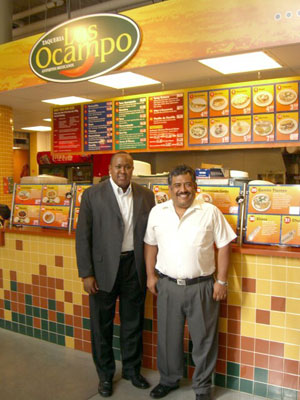Hussein Samatar facts for kids
Quick facts for kids
Hussein Mohamed Mohamud Samatar
|
|
|---|---|
| Xuseen Maxamed Maxamud Samatar حسين ساماتار |
|

Samatar, left, with Ramon Leon of the Latino Economic Development Center at the Midtown Global Market in 2011
|
|
| District 3 Representative on the Minneapolis School Board | |
| In office 11 January 2011 – 25 August 2013 |
|
| Personal details | |
| Born | 1964 Somalia |
| Died | 25 August 2013 (aged 48–49) Minneapolis, Minnesota, United States |
| Spouse | Ubah Jama |
| Children | 4 |
| Alma mater | Somali National University University of St. Thomas |
| Occupation | banker, community organizer |
Hussein Samatar (Somali: Xuseen Samatar, Arabic: حسين ساماتار) (1964 – 25 August 2013) was an important Somali American politician, banker, and community leader. He is known for starting the African Development Center in 2004. This center helped new immigrant businesses with small loans and expert advice.
Contents
Early Life and Education
Hussein Samatar was born in Somalia in 1964. He grew up in a diverse area called Kismayo. His family came from different parts of Somalia.
Samatar went to high school in Mogadishu, the capital city. He then studied at the Somali National University. He earned his first degree in 1991. He wanted to work as an economist. However, a civil war started just four days after he graduated.
Moving to the United States
Because of the war, Samatar moved to the United States in December 1991. He was among the first group of Somali people to move to Minnesota. He learned English with help from a librarian in Minneapolis.
Samatar continued his education in the U.S. He earned an MBA (Master of Business Administration) from the University of St. Thomas. He also completed special programs at the Humphrey School of Public Affairs and the Harvard Kennedy School of Government.
Samatar was married to Ubah Jama. They had four children together. He passed away on August 25, 2013, due to complications from leukemia.
Career and Community Work
Hussein Samatar had a successful career in banking. He worked at banks like Wells Fargo starting in 2002. He became a business banker, helping companies manage their money.
Founding the African Development Center
In 2004, Samatar started the African Development Center (ADC). He got help from organizations like the McKnight Foundation. The ADC's main goal was to offer financial services and education to new immigrants.
The center provided "microloans," which are small loans, to help people start or grow their businesses. By 2009, the ADC had given out $10 million in loans. This helped many immigrant families become successful.
Public Service and Politics
Samatar also became involved in public service. In 2006, he was appointed to the Minneapolis Library Board of Trustees. This was his first step into public office.
Four years later, in 2010, he made history. Hussein Samatar was elected to the Minneapolis School Board. He was the first Somali American in Minnesota, and likely the entire country, to be elected to public office. He officially started his term on January 11, 2011.
Samatar also served on the boards of many other community groups. These included the Citizens League and the Minneapolis Foundation. He worked to improve life for everyone in the city.
He was also interested in politics in Somalia. He often wrote about the political situation there. He supported efforts to build strong national parties.
Legacy and Impact
After Hussein Samatar's death, many people shared how much he meant to them. The Mayor of Minneapolis at the time, R.T. Rybak, called him "an extraordinary leader and a real friend."
Mayor Rybak also announced plans to honor Samatar. A street in Minneapolis would be named after him. In 2018, a new pedestrian and bike path was opened. It was named Samatar Crossing.
The Samatar Crossing helps connect different parts of Minneapolis. It links the Cedar-Riverside area to downtown and other neighborhoods. Minneapolis Mayor Jacob Frey said the crossing honored Samatar because he "worked to bridge communities." He did it with people, and now the crossing does it physically.

